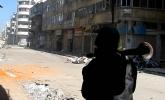 |
 |
ISW Profiles Free Syrian Army and Affiliates in Wake of Aid Announcement
Mar 1, 2013 - Anonymous




Contact: Maggie Rackl
(202) 293-5550 x205
WASHINGTON--As the U.S. looks to support Syria’s opposition in new ways, understanding the composition and structure of the Supreme Military Command will be vital in determining the viability of the organization and the most effective ways to support it.
Since U.S. Secretary of State John Kerry announced that the U.S. would provide non-lethal aid to the Free Syrian Army, ISW's Syria team has tracked the members of the newly-formed Supreme Military Command (SMC) through a series of analytic graphics.
‘Selected Supreme Military Command Members’ charts the Who's Who of the SMC and outlines their areas of operation throughout Syria.
Click chart to enlarge (PDF)

‘Syrian Military Command Structure’ depicts the internal organization of the new Supreme Military Command, including the five fronts and their departments and staff.
Click chart to enlarge (PDF)

For analysis of what U.S. non-lethal support may mean for the Free Syrian Army, read ISW Syria Analyst Elizabeth O'Bagy's Political Update: U.S. Secretary of State Announces Non-Lethal Aid to Free Syrian Army.
Elizabeth O’Bagy is Senior Research Analyst and Syria Team Lead at ISW. She is in a joint Master's/PhD program in Arab Studies and Political Science at Georgetown University and is working on a dissertation on women’s militancy. She is the author of Jihad in Syria and Syria’s Political Opposition.
For media inquiries, please contact Maggie Rackl at mrackl@understandingwar.org or at (202) 293-5550 x205.
###
The Institute for the Study of War (ISW) is a non-partisan, non-profit, public policy research organization. ISW advances an informed understanding of military affairs through reliable research, trusted analysis, and innovative education. We are committed to improving the nation’s ability to execute military operations and respond to emerging threats in order to achieve U.S. strategic objectives.